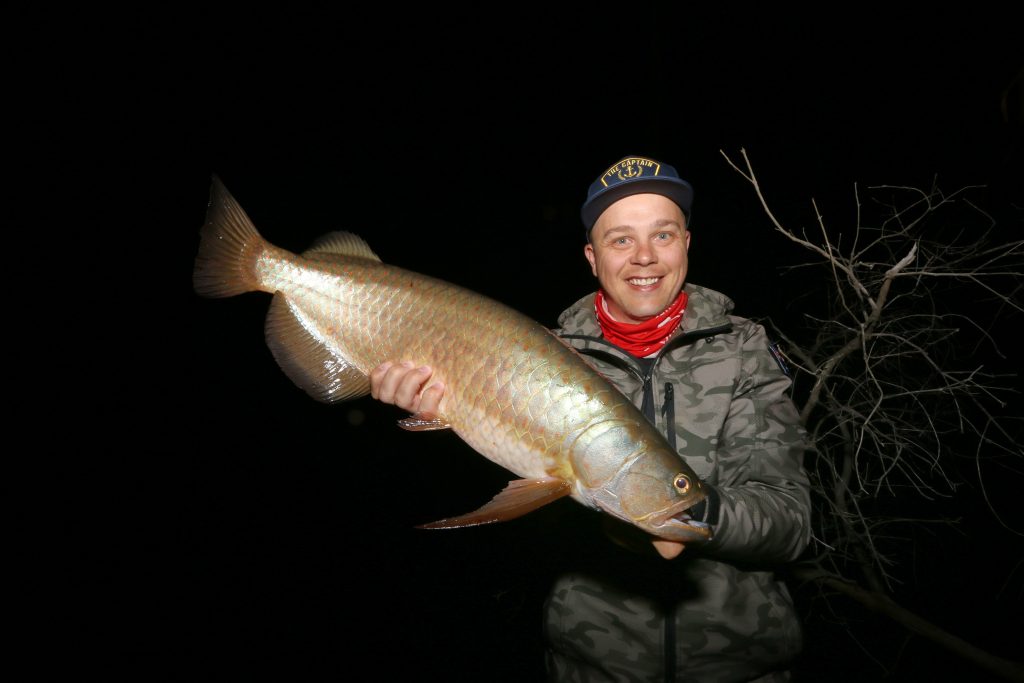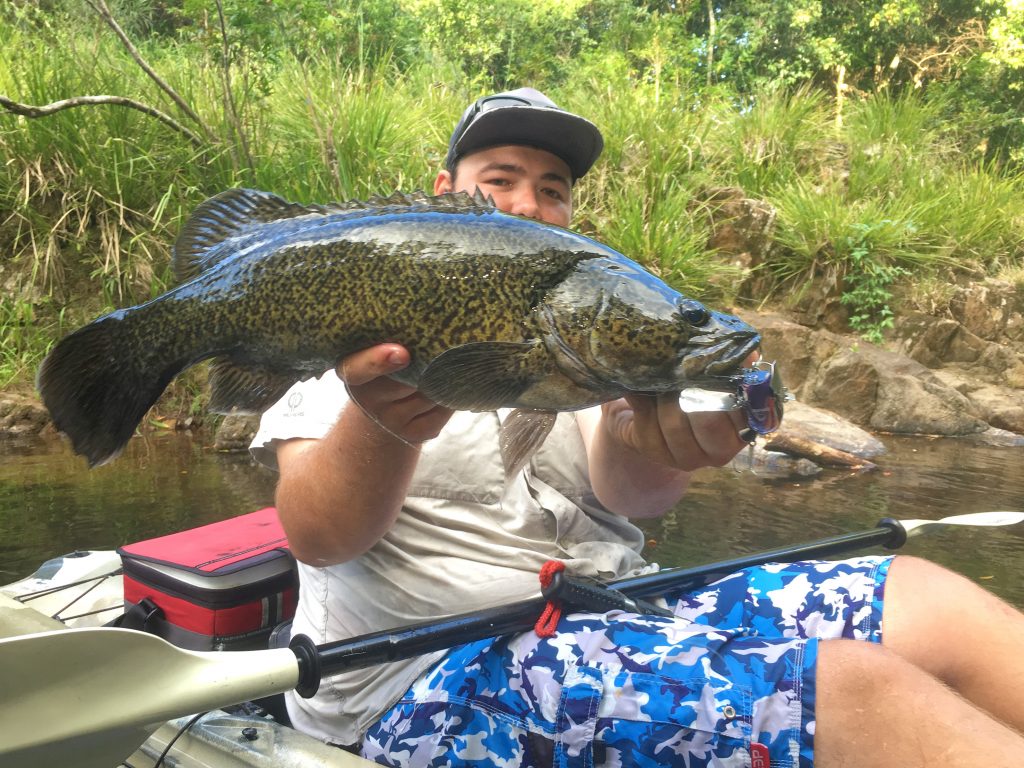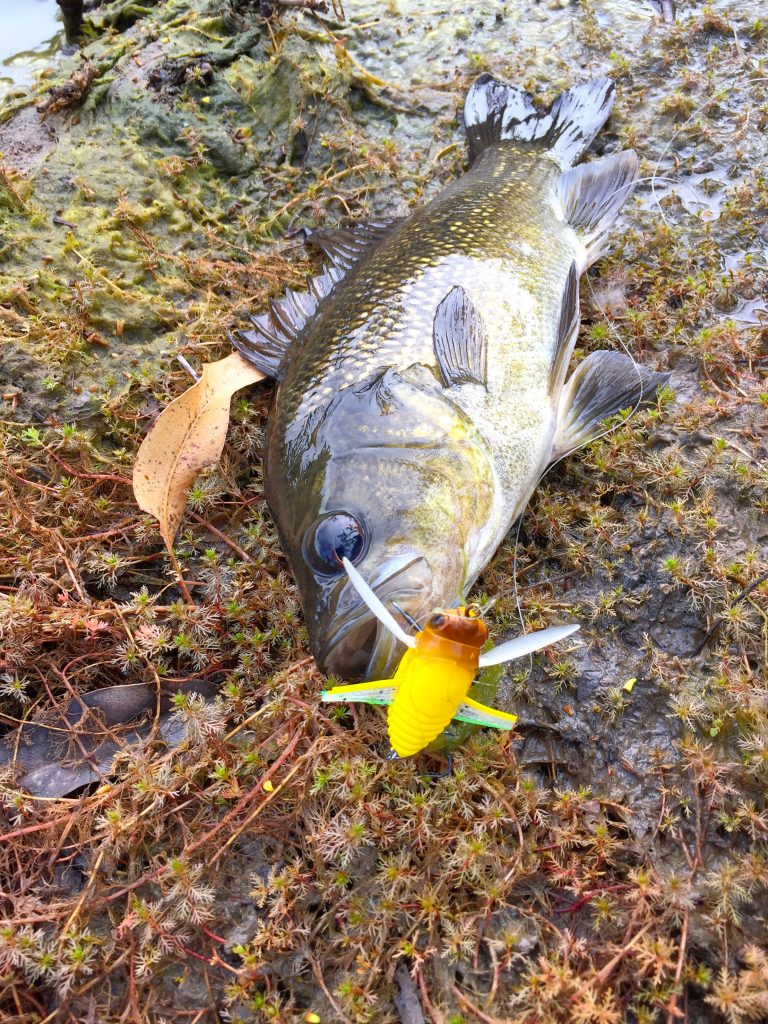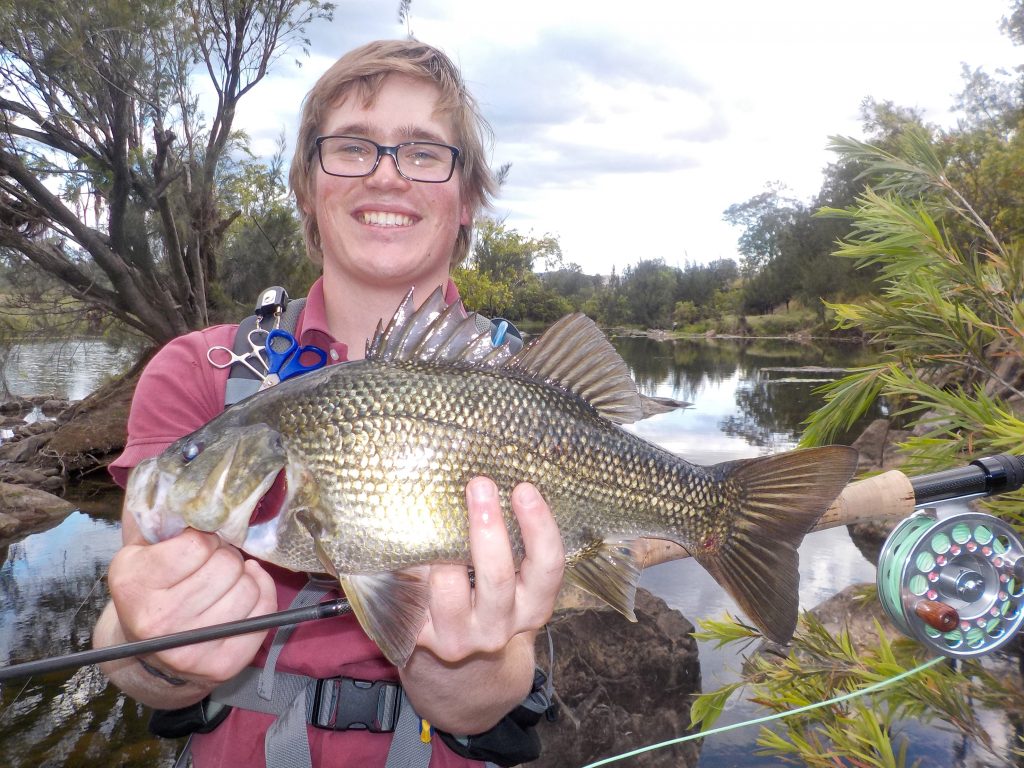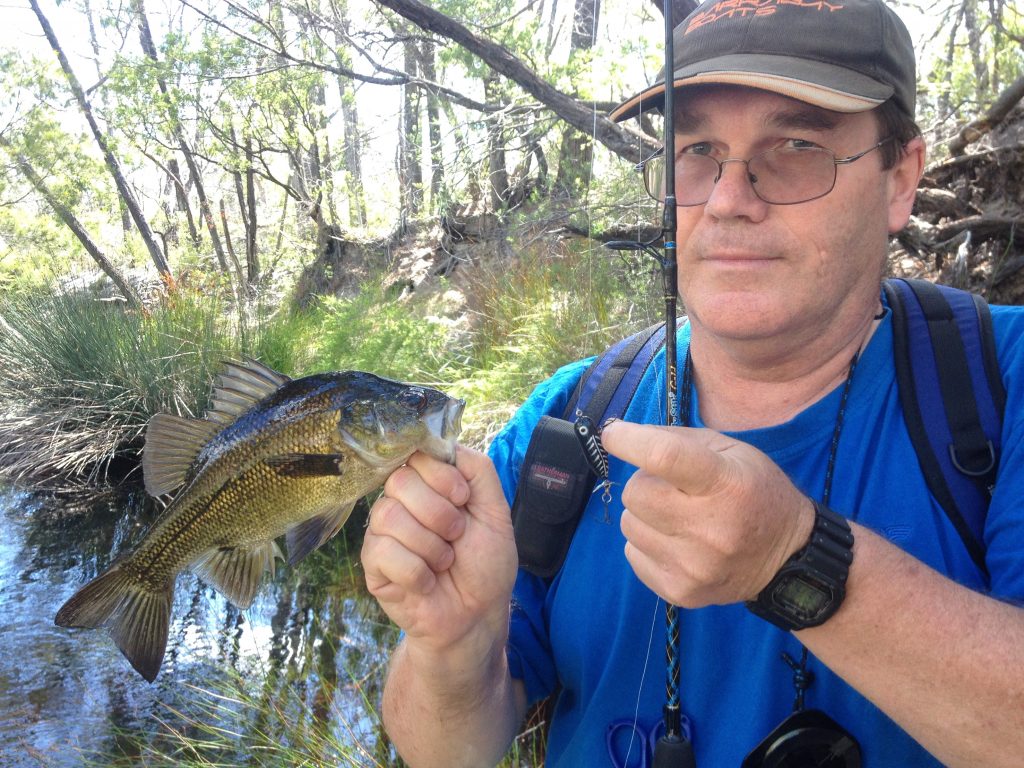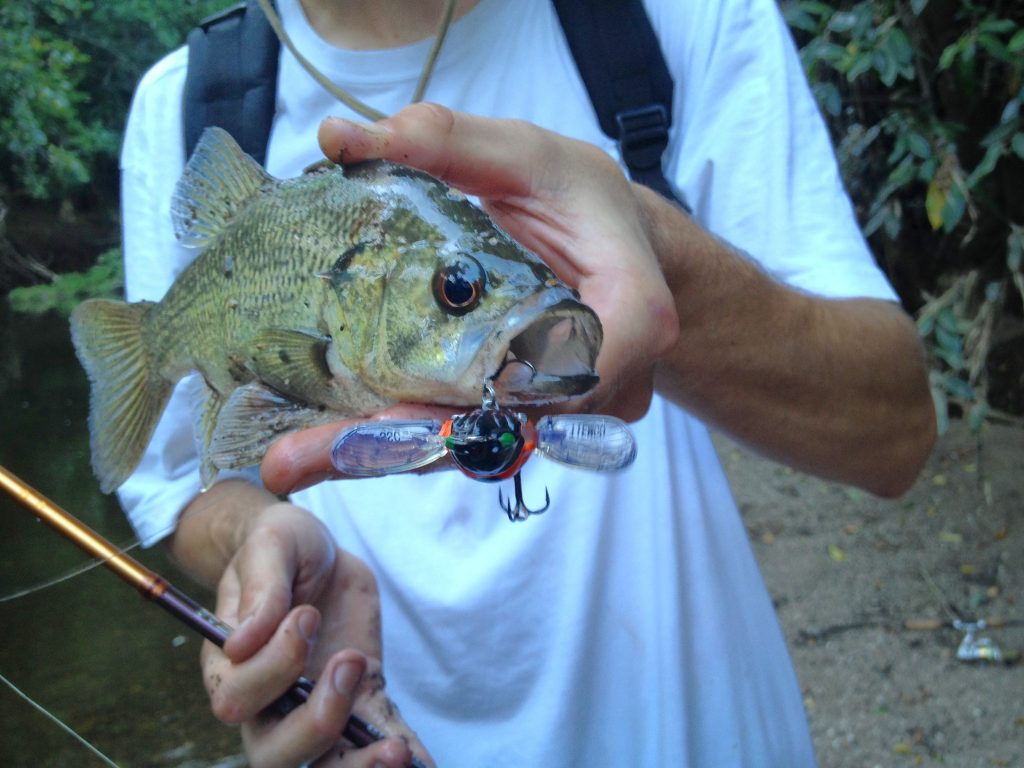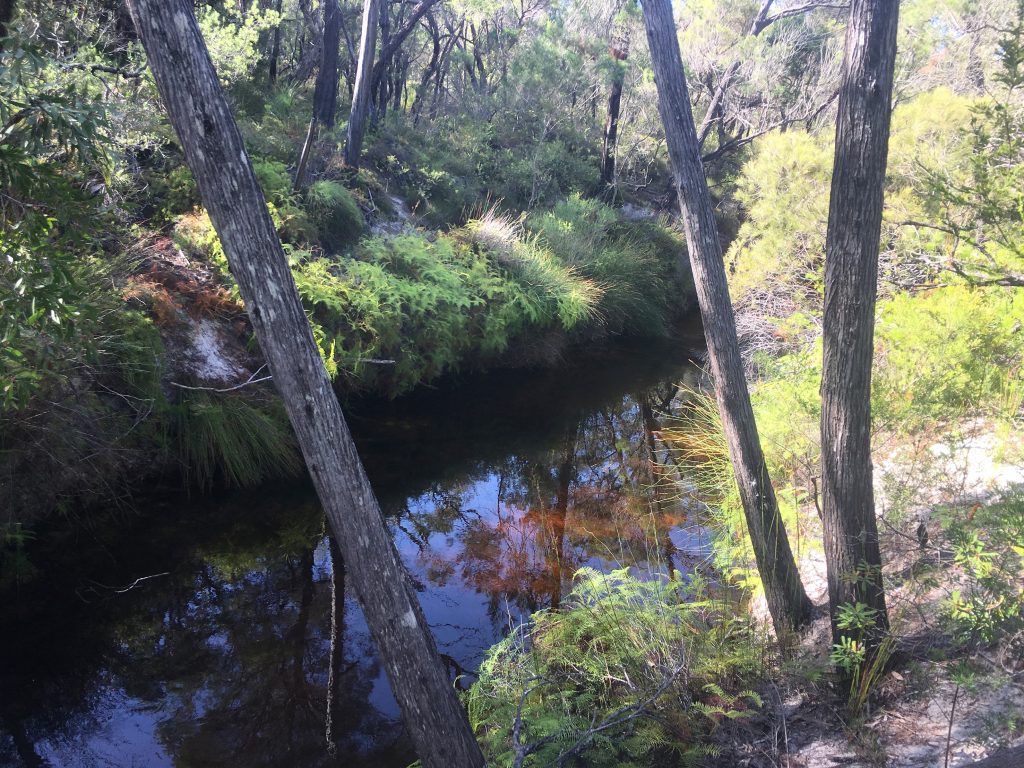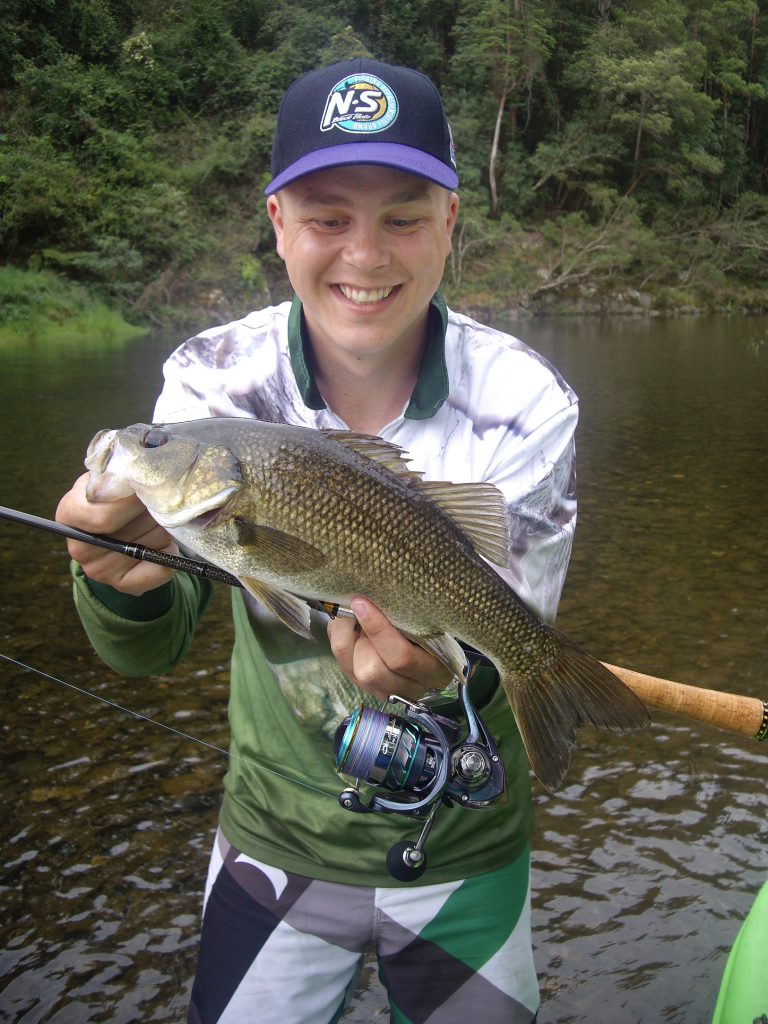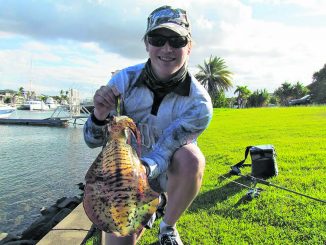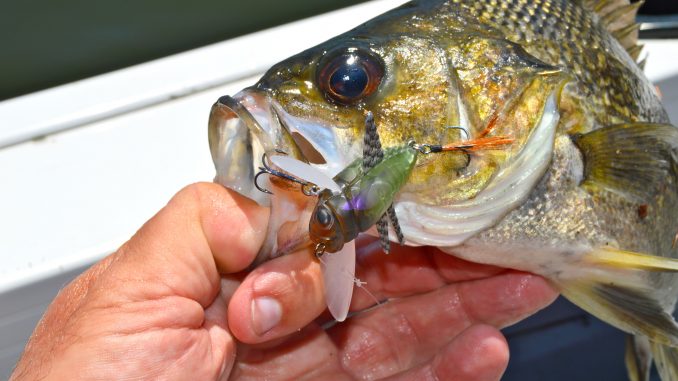
by Bob Thornton •
You’re slowly nosing up a freshwater creek on a hot, muggy afternoon, and you’re dripping with sweat from an arduous paddle. The trees that line the bank are gradually closing over to form a canopy over the deep, dark pools as you make your way further upstream. It’s clear no anglers have been in this stretch of creek for a while. The ringing of cicadas builds to a deafening crescendo overhead, and you reach into your cluttered tackle collection at your feet for a lure to imitate one of these winged invertebrates. With your offering tied on, your first cast to a likely corner sees the water erupt as if someone’s thrown a brick in the water. It’s going to be a good evening.
It’s scenarios like these that make this time of year so exciting for a bass angler, and anyone who regularly chases our bronze battlers will fantasize about sessions like these when they should be doing something else. For those yet to experience a topwater cicada bite, let me take you through the whole process.
THE PREY
I won’t bore you with entomology, mainly because it’s not my area of expertise! However, a basic understanding of cicadas and their habits will help you in your search for cicada-eating bass!
In Australia we have around 200 cicada species, and they range in colour from black/brown, all the way brighter colours like green, yellow and sometimes even orange! Most cicadas breed in the warmer months of the year, and the males can often be heard vibrating a drum-like plate on the side of their abdomens to call in a mate on warm afternoons. The best-known of Australian cicadas is the green grocer, which, as the name suggests, is a leafy green colour. The green grocer is credited to be one of the loudest insects in the world, with some recorded calls reaching 150 decibels, and let me tell you, in a small overgrown creek it can create quite an eerie atmosphere – but it’s worth braving!
When there’s trees and other cicada-harbouring vegetation lining the bank of any bass water, the bass will patiently wait for one of these clumsy morsels to fall into the water. When the males are ringing and drumming, it means there’s females flying around trying to find their male counterparts, and quite often it’s these unfortunate souls that end up in the water. The buzzing of their wings on the water’s surface only helps to call bass in, before they meet their watery doom. Such is the cruelty of the food chain.
LOCATION
Bass are targetable on cicada imitations virtually throughout their range, and in a variety of different environments, from ponds where they are stocked, to rivers and creeks, and even in some of Australia’s largest impoundments. The trick is to find a body of water that has bankside vegetation harbouring cicadas. The classic environment for this caper is a creek or river, but cicada-eating bass can be found in still waters as well, there just needs to be cicadas nearby!
As far as accessing these locations goes, there’s plenty of options. In areas where the water is too small to conveniently manoeuvre a kayak, walking or wading may be your only option. Don’t be knocked back by this idea. Not owning a boat or kayak does limit what waterways you can fish, but it certainly doesn’t put a cap on the fun you can have! My best bass fishing memories have come from the some of the smallest creeks – insignificant trickles that you could almost step over. Any slightly deeper, darker pools with adequate shade form the vegetation above is worth throwing a cicada in, even if the retrieve is only a few metres long!
In rivers and creeks where it is a little impractical to operate a trailer boat, but too wide in some areas to cast to the other bank from the shore, a kayak or canoe may be the best bet.
In most dams, trailer boats are allowed, however some only allow for paddle-only access, and some even have a no vessel policy, but allow for shore-based angling.
Whatever water you choose, make sure you pick a method of fishing that allows you access to all the likely areas, such as log pile, overhanging shrubs and banks, and any shade cast by cicada-holding structure!
TIMING
The general rule for bassing with topwater presentations is that it’s viable during any month with an ‘r’ in it. This is a very loose rule, however it’s a good starting point when picking apart any creek, river, or dam that holds bass. It’s during the very warmest parts of the year that bass start to refine their search to the insects that become particularly active at this time of year, and featuring heavily among them is the cicada. Their ringing can often be heard on hot afternoons as the sun starts to dip closer to the horizon, and any time the calls of male cicadas can be heard, it’s definitely worth tying on a topwater presentation.
Generally speaking, chasing a cicada bite, as with most topwater fishing, should be planned around the lowlight periods of the day, and sometimes after dark. There are specific scenarios where cicadas can be used to great effect during the day, however. Very occasionally, these mating rituals between cicadas can happen during the day. If drumming is audible at any time during the day, it pays to have a cicada tied on, even if you aren’t fishing it as your primary weapon. However, if you can see bass actively surfacing and chasing cicadas, it’s a no brainer.
Small creeks are an arena where cicada bites can go right through the day. They are often narrow enough to have shade over them all day from the canopy of trees above. With so much vegetation over the shade-cooled water, these creek-dwelling fish often feel comfortable to hunt cicadas all day, almost completely free of predation. Again, listening for sounds of cicadas will be your best clue as to what you should tie on!
CHOOSING YOUR PRESENTATION
There’s so many cicada imitations out there to choose from, it can be daunting to know where to start! Cicada-imitating lures range between around $7 and go beyond $30, and they all work! Let me take you through some basic types.
Paddlers and walkers
These are by far the most common type of cicada imitation. They often have their tow point at the rear, and their two arms that create the walking action usually fold away to make for easy storage, and also to look like wings. Some paddlers even have rattles in them to sound like the real thing!
Some brands have created soft-bodied cicada paddlers. The beauty of these designs is that they land softly, like a cicada, and their softness means that if a fish misses the lure in an attempt to strike, they’ll often come back for a second look without suspecting anything artificial.
Wakebaits
A wakebait is a crankbait with a small, vertically-angled bib, which makes the lures wobble like a normal crankbait, but on the surface. Many smaller models have been designed with cicada-like patterns on them, making these lures another great tool when chasing that cicada bite!
Flies
Anyone who knows me knows that I always find a way to fit flyfishing into my articles, so this one will be no different. Surface flies can be an excellent way to imitate a cicada, as they land very softly, and the material flies are made of often resembles the exact texture of the real thing. If you’re a fluff chucker, definitely bring the long wand next time your after the cicada eaters!
Others
Many other lure types have been designed with cicada patterns on them. Fizzers, poppers and hollow-bodied soft plastics lures are all potential choices, just think about what they local cicadas look like, and match the lures to them!
FISHING CICADAS
Obviously, if you’re using a lure designed to imitate a cicada, you’ll want to impart an action that resembles a cicada! Imparting a good action on the surface can be aided by the use of monofilament leaders, as this material floats. Fluorocarbon, while a worthy tool for the job, sinks and can affect the desired action of certain lures. Testing your lures before fishing with them is the best way to work out whether to go fluoro or mono.
Plenty of anglers will cast their cicada out and simply straight retrieve, fizz, or pop it back to where they’re positioned. While this works fine, if you really want to provoke a feeding response from a frisky summertime bass, you got to think a bit like a cicada!
When a cicada falls in, there’ll often lie stationary for a few moments so as not to arouse any nearby predators. Seconds later, there’ll buzz their wings gently on the surface. At this point, some will manage to fly away, while others will resort to a desperate attempt to propel themselves to the shore nearby.
To imitate this with a lure, you should let the lure or fly sit stationary where it lands. If you accidentally cast into a tree, even better! In this case you should try to jiggle it off so it lands naturally in the water. I believe sometimes the leaves you shake off when doing this alerts the bass to the potential snack hanging above! After allowing your offering to sit for a few seconds, a great trick is to gently shake the rod tip to imitate the wing flapping; this also works with a fly rod. After a few seconds of this action, then I usually commence the prescribed action, whether it be a straight retrieve in the case of paddlers and wakebaits, fizzes and pops in the case of fizzes and poppers, or gentle sliding strips for flies.
Intermittent pauses are just another trick the angler can employ during the retrieve. Bass love to hit a stationary lure, particularly if the bite is tough!
Strikes can happen at anytime during this process, so it pays to be on the ball. Bass have an uncanny habit of striking when your mind is elsewhere, and can leave even the most seasoned anglers dead-eyed, wet and shaking.
GOING GLOBAL
Many smart anglers have come to realise that cicada imitations are effective not just on bass, but a variety of light-tackle sportfish, in fresh and saltwater! Travelling north, I’ve had the absolute pleasure of casting cicada lures into crystal clear rainforest streams in search of jungle perch and sooty grunter. Closer to home, I’ve lobbed cicadas under mangrove overhangs for weary bream on hot summer afternoons. Further south, I’ve scaled up the tackle slightly to tempt Murray cod from their lairs, as while they have a preference for bigger tucker, they won’t often knock back a helpless, buzzing cicada as an easy feed.
Even in Tasmania, some switched on anglers are tossing soft-shelled cicada imitations into the snow-fed streams of the highlands to trick the local trout, with some great success!
In all these scenarios, the same principals apply. The only thing to adjust is the tackle, the layers of clothing you wear and the amount mozzie spray you apply!
FEEL THE BUZZ
If you’ve ever wanted to know why bass anglers get so weird when they hear cicadas ringing in the trees outside on a hot afternoon, get your hands on some cicada imitations and head down to your local bass creek, river, pond or dam.
The anticipation of that explosive topwater strike is rewarding enough in itself, let alone the satisfaction of landing, unhooking, photographing and finally releasing the East Coast’s premier sportfish.
Now is the perfect time to be preparing for the summer ahead. Hopefully by the end of this bass season, your hands will be covered in bass spikes, your legs spotted with thistle rash, and your camera full of memories – all thanks to one loud little invertebrate!

